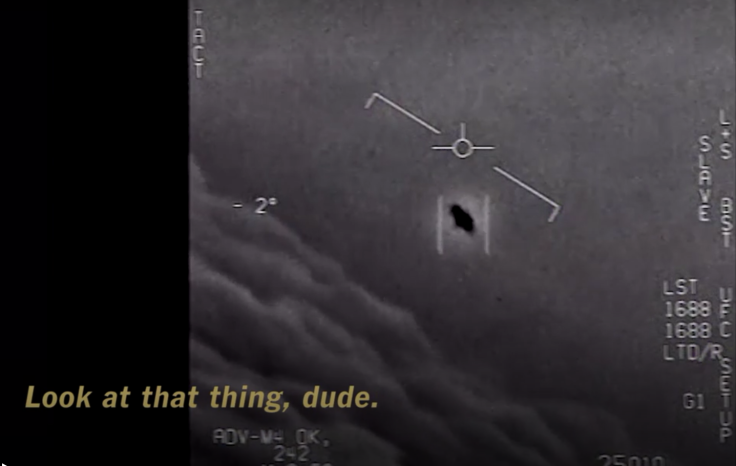On Saturday, The New York Times ran a bedazzling exposé on a secret Defense Department program that funneled money to a hotel billionaire to research this century’s most compelling UFO evidence. "Glowing Auras and ‘Black Money’: The Pentagon’s Mysterious U.F.O. Program” is headed by a mind-melting video of an unknown object tracked by a Navy fighter pilot, just the first of several blockbuster revelations, like a Las Vegas facility where government contractors store “metal alloys and other materials… recovered from unidentified aerial phenomena.” But left unexplored are the confounding motives for the secretive public-private UFO program and background on sources whose claims warrant a level of scrutiny not evident in the reporting.
The New York Times reports that $22 million, masked as “black money” within the Defense Department’s $600 billion budget, went to a Pentagon program called the Advanced Aerospace Threat Identification Program, which investigated UFO (Unidentified Flying Objects) reports. Evidence claimed by former military intelligence official Luis Elizondo, who ran the program, include high velocity craft with “no visible signs of propulsion,” anomalous materials and video recordings, complete with chilling audio from baffled pilots with movie-ready lines like “There’s a whole fleet of them.”
The program, originally greenlit by Nevada senator Harry Reid in 2007, either ended in 2012 or is ongoing. Despite the Pentagon-centered framing, the Times story reveals most of the money went to Bigelow Aerospace, which “hired subcontractors and solicited research for the program.”
Bigelow Aerospace is owned by Robert Bigelow, described as a “billionaire entrepreneur and longtime friend of Mr. Reid’s.” Bigelow has donated tens of thousands to Reid and Searchlight Leadership Fund, Reid’s Political Action Committee, and the complete absence of their financial relationship from the Times story neatly excises an alternate interpretation of the Pentagon program as essentially a pass-through for public money to fund a billionaire donor’s pet project, making the program’s secrecy as much about its political unseemliness as its explosive evidence.
Even more damning than the unmentioned possibility of corruption is one of the story’s sources: Harold E. Puthoff. Describing Puthoff as “an engineer who has conducted research on extrasensory perception for the C.I.A. and later worked as a contractor” for Bigelow’s program doesn’t come close to approaching the level of skepticism Puthoff’s contribution to the story warrants. A former Scientologist who used L. Ron Hubbard’s e-meter to search chicken eggs for psychic sensitivity, Puthoff conducted ludicrously flawed, military-funded studies into “remote viewing” (“seeing” distant targets with the mind like, say, Soviet military installations), got duped by psychic fraud Uri Geller and has since been a major proponent of pseudoscientific zero-point energy. If Puthoff is indicative of the caliber of researchers brought aboard by Bigelow, then there’s likely to be far less substance to the program’s findings than its most sensational claims suggest.
Even the video, with its mysterious, barrel-rolling craft, might soon reveal some obvious flaws. Reporter Leslie Kean (one of the three sharing the NYT byline), author of UFOs: Generals, Pilots and Government Officials Go on the Record, has been instrumental in bringing similarly enigmatic military footage to the public’s attention, including a video released by the Chilean government at the beginning of 2017. Kean’s reporting on that sighting dismissed or downplayed convincing explanations provided by independent investigators, focusing as much on the legitimacy of their venue as their conclusions. A similar debunking of the Times' new footage is complicated by the Defense Department's refusal to share the date and location of the sighting.
There is no smoking gun that disproves the existence of scientist-stumping UFO materials or provides a mundane explanation for extraordinary UFO sighting footage, but there are more than enough unspoken assumptions, unannounced motives and dubious sources present in the NYT’s report to justify far more skepticism. And while it’s not ideal countering big revelations with little more than insinuations of untrustworthiness, it’s the only option made available by the outsized secrecy surrounding the privatization of UFO research.
In May, I called for Robert Bigelow to put up or shut up about UFOs after a 60 Minutes appearance during which he said “There has been and is an existing presence, an ET presence” on or around Earth:
“Bigelow should make a choice between revealing what he knows — even if it means burning sources or leaking classified information — and relinquishing the rhetoric of certainty and insinuation. Otherwise we might be lead to the conclusion that Bigelow is deliberately withholding from the population of Earth the most important truth in the history of our species.”
Now that it’s been revealed that Bigelow’s secret-hoarding has the backing of powerful senators and government money, it’s more important than ever that UFO disclosure step out from the cover of anonymous sources and incomplete information to become the rightful knowledge of the democratic citizenry bankrolling Bigelow’s investigation.














![[EG April 19] Best 'Stardew Valley' Mods That Will Change](https://d.player.one/en/full/226012/eg-april-19-best-stardew-valley-mods-that-will-change.png?w=380&h=275&f=955520b8313253ee3c39c791f6210f38)



